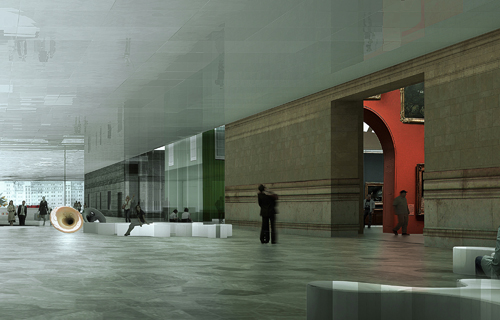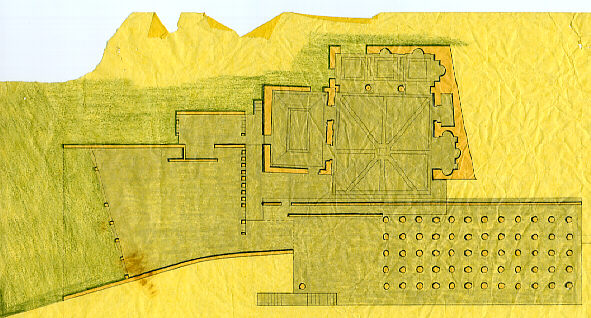2009.10.21 11:58
Really, what boundaries have you pushed?
I think there's a pretty clear distinction between pushing boundaries actively and pushing boundaries passively.
2009.10.21 11:40
Really, what boundaries have you pushed?
...maybe there's a subconscious trend.
August 1977
There's that open door at the end of St. Peter's Colonnade which opens up to a long corridor and ultimately the Scala Regia. As usual, a Swiss Guard was there standing at attention. I walked up the few steps anyway. The guard remained motionless until I reached the threshold, when he very subtly dipped that spear/ax thing about a quarter inch in my direction. Then I winked at him and returned back to the crowd.

2009.10.21 08:41
Really, what boundaries have you pushed?
Getting back towards Logan Circle, I go into the Basilica of Sts. Peter and Paul, where I haven't been in over ten years, and haven't been in while empty in 25 years. For some reason, I found it to be enormous inside. I guess it just is enormous, and actually quite nice architecturally, very Renaissance Rome. I notice within one of the side chapels is the chair used by Pope John Paul II while he was in Philadelphia 1979. Since no one else was around and the railing to the chapel was only 2 feet tall, I decided to go sit in the chair myself. I found those few seconds sitting to be quite intense, so I got up quickly because otherwise I would have gotten way too comfortable.
Well, what do you do after having sat in one of the Pope's chairs? To be honest, I was in a very good mood the rest of the day.
| |
2009.10.20 23:55
Really, what boundaries have you pushed?
I think Flaubert was advocating an active position toward both life and work, rather that a passive position.
2009.10.20 23:50
dear old people...
Maybe "pushing boundaries" is their favorite clichés even.
2009.10.20 23:47
dear old people...
Maybe some old people in power are thinking of making cloning and abortion mandatory so that new young people just stop coming into existence.
2009.10.20 23:28
Really, what boundaries have you pushed?
"Be regular and orderly in your life so that you may be violent and original in your work."
Gustave Flaubert
2009.10.20 23:38
Really, what boundaries have you pushed?

phantom opera buffs, 1985
| |
2009.10.20 23:24
Really, what boundaries have you pushed?
I've never personally been committed to a psych ward, but there was a time when I well knew all the steps to get someone committed, and have indeed succeeded in having someone committed many, many times. As a result, I have visited a variety of different psych wards on many, many occassions, and, hence, I have often visited that boundary between sanity and insanity. Of course, it is an unfortunate place, but, more to the point, it's never comfortable, and sometimes even down-right scary.
You don't play with the boundary there either. You don't push it, and you cetainly don't try to blur it. You learn to keep it steady and clear, for the benefit of both parties.
2009.10.19 11:35
anybody know where I can find classical/renaissance blueprints?
2005.11.10
When I went to the Fine Arts Library of the University of Pennsylvania on 14 May 1999 it was to see an actual etching of the Ichnographia of the Campo Marzio for the first time. I felt sure I would see the Ichnographia at the Penn library because within the "Illustration Credits" of Jennifer Bloomer's Architecture and the Text (p. 215) it states:
"Giovanni Battista Piranesi, details from Il Campo Marzio dell'Antica Roma: Ichnographia. Etching, six plates. Used by permission of the Fine Arts Library of the University of Pennsylvania."
I asked at the reference desk about Il Campo Marzio..., and I was told there was no such holding in the catalogue. I mentioned the citing in Bloomer's book, and I even went into the book stacks and got Bloomer's book itself to show the librarian. The head librarian was called and he thought to look in the old card catalogue of the Rare Book Room--Penn was then still in the midst of filling data onto it's fairly new online book catalogue and the Rare Book Room holdings were not yet in the electronic catalogue. Sure enough, Penn does possess a 1762 edition of Il Campo Marzio..., but even that was hard to find because the call number on the card was a typographic error. Alas, I finally had an actual Ichnographia unfolded in front of me and within minutes I discovered that the plan I was now looking at was not entirely the same as the plan reproduction that I had up till then been used to looking at. And architectural history changed a little bit that day.
Then knowing that the Ichnographia exists in two versions, I went back to Bloomer's Architecture and the Text to see which version of the Ichnographia are reproduced in detail there. Strangely enough, the details of the Ichnographia reproduced in Architecture and the Text DO NOT match the 1762 Ichnographia at the Fine Arts Library of the University of Pennsylvania.
2009.10.19
Sometime late 2007 I came in possession of the Spring 1980 edition of Penn In Ink, the newsletter of the Graduate School of Fine Arts University of Pennsylvania. On the inside back cover is offered "An Original Peranesi [sic] Offering -- The Graduate School of Fine Arts is pleased to offer from its Rare Book Room collection to its alumni, students, and friends a limited edition reproduction of an original Giovanni Battista Peranesi [sic] engraving, the 1762 composite plan of Ancient Rome dedicated to Robert Adam, as shown above."
There may indeed be a second (state) original engraving of the "composite plan of Ancient Rome" (i.e., the Ichnographia Campus Martius) within the Rare Book Room collection of the Graduate School of Fine Arts, but, nonetheless, the reproduction offered does not match the (first state) Ichnographia engraving within the Il Campo Marzio publication within the Graduate School of Fine Arts Rare Book Room.
| |
2009.10.19 10:30
anybody know where I can find classical/renaissance blueprints?
Has anyone else seen Blew Prince: so many answers, so little inclination. by Rita Novel?
2009.10.17 11:08
Duchamp to direct THE LUCKY BUMS
"The same "sense of loss" that supports history and mourning also supports the damnatio memoriae, which is both an enforced and denied nostalgia. There must be a sense that something has fallen out of representation, that it was at one time but it is no longer--a sense that something has been lost. If not, then memory truly fails and with it the force of the damnatio memoriae. The force of the rehabilitation has much more to do with the reenactment of the death and condemnation of Flavian than with an account of the events of 394. The survivors have always remembered Flavian, but it is only after the rehabilitation that they can "satisfy the debt of duty owed the dead"--that is, acknowledge the irremediable fact of his loss, through the act of mourning. The writing of history, too, is motivated more by guilt and a desire to mourn than by a desire merely to evoke. The survivor is the one who remains to see that the proper rites are performed for the dead and for that part of the self which has perished, and in the end compulsively to rehearse that loss once again by writing the history" [re-accurately].
--CWH [SL]
The virgin wolfs, the Hirpini and the snails (spirialling), at the end of the axis of war.
So there was a connotation after all.
The Eutropia question.
"You do know the Sabine word for wolf, don't you?"
The Jennewein question.
"Is the axis of war the sacred axis or the profane axis?"
The Adam obsevation.
"Look, she dropped another hair pin."
The Duchamp question.
"Are reenactments virtual or real?"
2009.10.06 15:59
Examples of modern exterior with traditional interior
somewhat akin to the Getty...
 
REX, Munch Museum, 2009
The compartmentalized approach leads to any number of mix-up possibilities.
otherwise...

Level 1: lobby, bar. restaurant, spa, fitness, banquet rooms.
OMA and Herzog & de Meuron, Hotel Astor Place, 1999.

SL, Mayor's House, 1990.
|